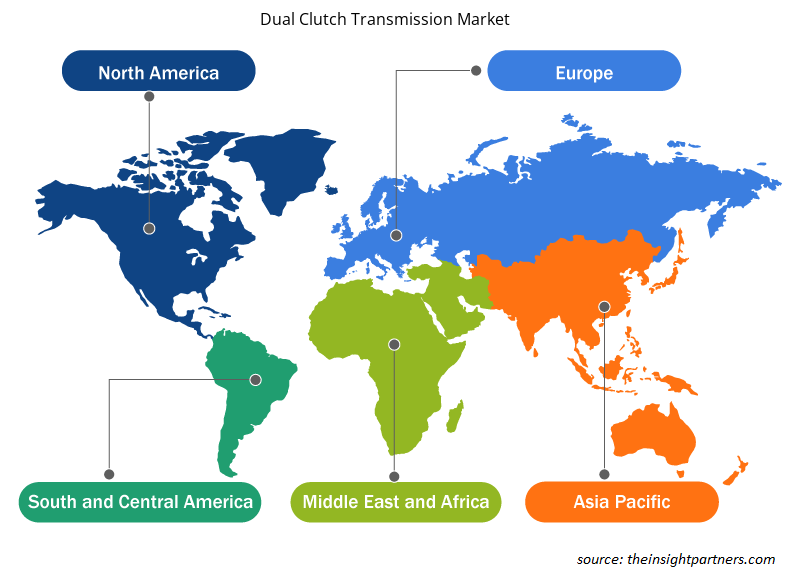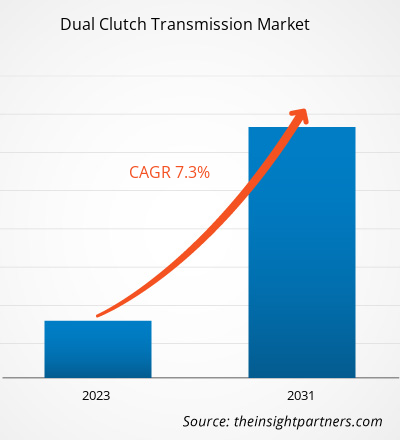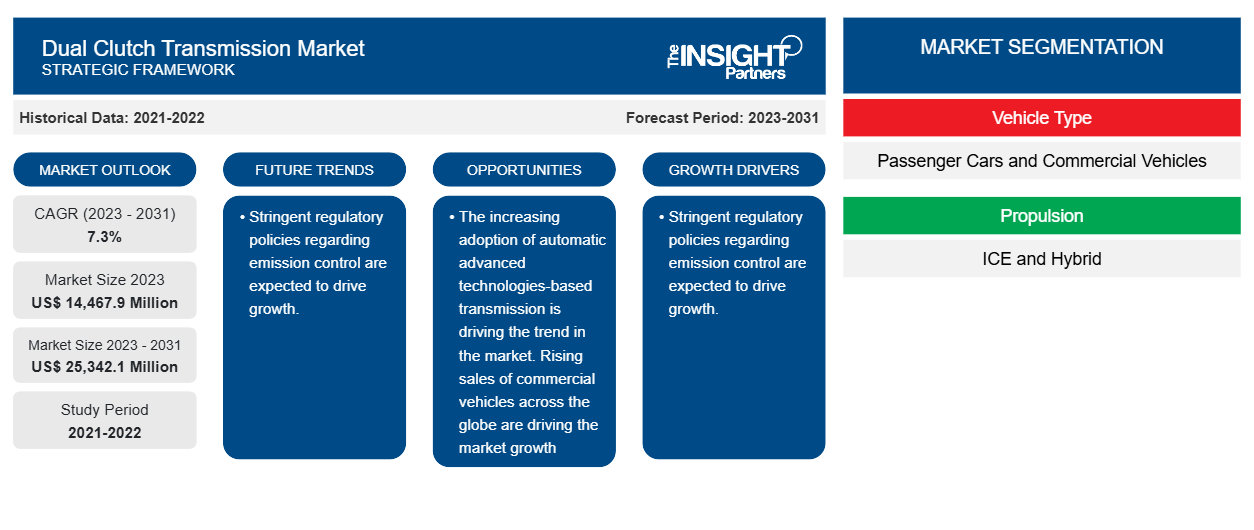Se proyecta que el tamaño del mercado de transmisión de doble embrague alcance los 25.342,1 millones de dólares estadounidenses para 2031, frente a los 14.467,9 millones de dólares estadounidenses en 2023. Se espera que el mercado registre una CAGR del 7,3 % durante el período 2023-2031. La creciente adopción de transmisiones automáticas basadas en tecnologías avanzadas está impulsando la tendencia en el mercado. Las crecientes ventas de vehículos comerciales en todo el mundo están impulsando el crecimiento del mercado.
Análisis del mercado de transmisión de doble embrague
El mercado de transmisión de doble embrague ( DCT ) está impulsado principalmente por el aumento de las ventas de vehículos comerciales y de pasajeros en todo el mundo. La demanda de transmisión de doble embrague tiene la mayor participación en la región de Asia Pacífico debido al aumento de las ventas de los vehículos en India, China y Japón. En los vehículos comerciales y de pasajeros, la transmisión de doble embrague utiliza un embrague automático para mejorar la eficiencia del combustible y ofrecer un alto rendimiento de los vehículos. La transmisión de doble embrague utiliza dos discos de embrague que permiten un cambio rápido de marchas sin ningún retraso de entrada.
Descripción general del mercado de transmisión de doble embrague
Una transmisión de doble embrague ( DCT ) es una transmisión manual automatizada en vehículos comerciales y de pasajeros . Este sistema de transmisión utiliza dos embragues para establecer conjuntos de marchas pares e impares. La tecnología de transmisión de doble embrague ofrece dos transmisiones manuales. Una ruta proporciona la primera, tercera, quinta y posiblemente séptima marchas para cambiar automáticamente, mientras que la otra proporciona relaciones de transmisión pares y transmisión de marcha atrás. Con la creciente demanda de mejorar la eficiencia del combustible y el rendimiento del vehículo, se utiliza la tecnología de transmisión de doble embrague. La tecnología de transmisión de doble embrague ofrece un cambio de marchas sin problemas y una distribución de potencia eficiente para vehículos comerciales y de pasajeros.
Personalice este informe según sus necesidades
Obtendrá personalización en cualquier informe, sin cargo, incluidas partes de este informe o análisis a nivel de país, paquete de datos de Excel, así como también grandes ofertas y descuentos para empresas emergentes y universidades.
- Obtenga las principales tendencias clave del mercado de este informe.Esta muestra GRATUITA incluirá análisis de datos, desde tendencias del mercado hasta estimaciones y pronósticos.
Impulsores y oportunidades del mercado de transmisión de doble embrague
Se espera que las políticas regulatorias estrictas sobre control de emisiones impulsen el crecimiento.
En América del Norte, se espera que las iniciativas del gobierno, las políticas federales y los programas para varias industrias impulsen el mercado de autobuses eléctricos. Estados Unidos, Canadá y México firmaron el acuerdo comercial TLCAN. El acuerdo comercial ayudó a los fabricantes de automóviles con el aumento del número de instalaciones de fabricación y la mejora de la cadena de suministro de autopartes. El gobierno de México está muy centrado en atraer IED para impulsar el sector manufacturero del país. Fabricantes de automóviles como BMW, Audi y Mercedes están invirtiendo en el país. Esto se debe a los diversos beneficios fiscales, así como a las importaciones libres de impuestos que ofrece el gobierno mexicano. Además, varios otros fabricantes de automóviles tienen una base existente en el país.
Los gobiernos de varios países de la región APAC se están centrando en la fabricación de automóviles y en sus respectivos países. Por ejemplo, a través de Made in China in 2025, el gobierno de China está apoyando a las empresas locales para que compitan con los fabricantes de automóviles extranjeros y a nivel mundial. Además, las iniciativas del gobierno indio, como el Automotive Mission Plan 2016-26, brindan apoyo gubernamental a la creciente industria de fabricación de automóviles del país. Por lo tanto, estas iniciativas gubernamentales respaldarían el crecimiento del sector automotriz en la región, lo que respaldará el crecimiento del mercado de transmisión de doble embrague en APAC.APAC region are focusing on the manufacturing of automobiles and their respective country itself. For instance, through Made in China in 2025, the government of China is supporting local companies to compete with foreign automakers and to compete globally. Furthermore, initiatives by the Indian government, such as the Automotive Mission Plan 2016-26, provide government support to the country’s growing automotive manufacturing industry. Therefore, these government initiatives would support the growth of the automotive sector in the region, which will support the growth of the dual clutch transmission market in APAC.
Se espera que la creciente adopción de sistemas de embrague basados en tecnología avanzada impulse el crecimiento del mercado
Los actores clave del mercado están adoptando sistemas de transmisión basados en tecnología avanzada para lanzar nuevos modelos de vehículos. Por ejemplo, en abril de 2024, Stellantis NV lanzó un sistema de transmisión de doble embrague electrificado en Italia. La empresa planeó una inversión de alrededor de 260 millones de dólares para el establecimiento de la industria automotriz italiana en el Parque Automotriz Mirafiori. Stellantis NV también anunció 108 millones de dólares adicionales para impulsar el potencial del Fiat 500e. Se espera que este aumento en la inversión y el lanzamiento del desarrollo de los nuevos sistemas DCT por parte de los actores clave creen amplias oportunidades para el crecimiento del mercado.Stellantis N.V. launched an electrified dual clutch transmission system in Italy. The company planned an investment of around US$ 260 million for the establishment of the Italian automotive industry in the Mirafiori Automotive Park. Stellantis N.V. also announced an additional US$ 108 million to boost the potential of the Fiat 500e. Such an increase in the investment and launching of the development of the new DCT systems by the key players is expected to create ample opportunity for market growth.
Análisis de segmentación del informe de mercado de transmisión de doble embrague
Los segmentos clave que contribuyeron a la derivación del análisis del mercado de transmisión de doble embrague son el tipo de vehículo, la propulsión, la clase de vehículo y la geografía.
- Según el tipo de vehículo, el mercado se divide en turismos y vehículos comerciales. Entre estos, los turismos tuvieron la mayor participación en 2023. Esto se debe al aumento de las ventas de turismos en todo el mundo.
- Dependiendo del tipo de propulsión, el mercado se divide en ICE e híbridos. Entre estos, los ICE tuvieron la mayor participación en 2023. Esto se debe al aumento de las ventas de vehículos en todo el mundo. Según la Agencia Internacional de la Energía, las ventas mundiales de automóviles aumentaron a 92,72 millones de unidades en 2022, frente a los 82,8 millones de unidades de 2021.
- Según la clase de vehículo, el mercado se divide en A/B, C, D, E y superiores, y SUV y marchas delanteras (6, 7 y 8 y superiores). Entre estos, los SUV tienen la mayor participación debido a la creciente adopción de DCT en los vehículos SUV.DCT in SUV cars.
Análisis de la cuota de mercado de la transmisión de doble embrague por geografía
El alcance geográfico del informe del mercado de transmisión de doble embrague se divide principalmente en cinco regiones: América del Norte, Asia Pacífico, Europa, Medio Oriente y África, y América del Sur y Central.
Se espera que Asia Pacífico tenga la mayor participación en el mercado de transmisión de doble embrague debido al aumento de la demanda y la venta de automóviles en países en desarrollo como China, India y Japón. En 2023, según la Asociación de Fabricantes de Automóviles de China, se vendieron alrededor de 26 millones de unidades de automóviles de pasajeros en China. India ocupó el segundo lugar como mercado más grande en la región de Asia Pacífico. Estos factores son responsables del crecimiento del mercado de transmisión de doble embrague durante el período de pronóstico.
Perspectivas regionales del mercado de transmisión de doble embrague
Los analistas de Insight Partners explicaron en detalle las tendencias y los factores regionales que influyen en el mercado de transmisión de doble embrague durante el período de pronóstico. Esta sección también analiza los segmentos y la geografía del mercado de transmisión de doble embrague en América del Norte, Europa, Asia Pacífico, Medio Oriente y África, y América del Sur y Central.

- Obtenga datos regionales específicos para el mercado de transmisión de doble embrague
Alcance del informe de mercado de transmisión de doble embrague
| Atributo del informe | Detalles |
|---|---|
| Tamaño del mercado en 2023 | US$ 14.467,9 millones |
| Tamaño del mercado en 2031 | US$ 25.342,1 millones |
| CAGR global (2023 - 2031) | 7,3% |
| Datos históricos | 2021-2022 |
| Período de pronóstico | 2023-2031 |
| Segmentos cubiertos | Por tipo de vehículo
|
| Regiones y países cubiertos | América del norte
|
| Líderes del mercado y perfiles de empresas clave |
|
Densidad de actores del mercado: comprensión de su impacto en la dinámica empresarial
El mercado de transmisiones de doble embrague está creciendo rápidamente, impulsado por la creciente demanda de los usuarios finales debido a factores como la evolución de las preferencias de los consumidores, los avances tecnológicos y una mayor conciencia de los beneficios del producto. A medida que aumenta la demanda, las empresas amplían sus ofertas, innovan para satisfacer las necesidades de los consumidores y aprovechan las tendencias emergentes, lo que impulsa aún más el crecimiento del mercado.
La densidad de actores del mercado se refiere a la distribución de las empresas o firmas que operan dentro de un mercado o industria en particular. Indica cuántos competidores (actores del mercado) están presentes en un espacio de mercado determinado en relación con su tamaño o valor total de mercado.
Las principales empresas que operan en el mercado de transmisión de doble embrague son:
- Magna Internacional Inc.
- Schaeffler Technologies AG & Co. KG
- BorgWarner Inc.
- Daimler AG
- Volkswagen AG
- ZF Friedrichshafen AG
Descargo de responsabilidad : Las empresas enumeradas anteriormente no están clasificadas en ningún orden particular.

- Obtenga una descripción general de los principales actores clave del mercado de transmisión de doble embrague
Noticias y desarrollos recientes del mercado de transmisión de doble embrague
El mercado de transmisión de doble embrague se evalúa mediante la recopilación de datos cualitativos y cuantitativos posteriores a la investigación primaria y secundaria, que incluye publicaciones corporativas importantes, datos de asociaciones y bases de datos. A continuación, se enumeran algunos de los desarrollos en el mercado de transmisión de doble embrague:
- Punch Powertrain lanza su innovador sistema DCT con un diseño revolucionario, más compacto y asequible. El DT1 se lanzó en la India y debutó en el reciente lanzamiento de Altroz DCA de Tata Motors. (Fuente: sitio web de la empresa, marzo de 2022)
- Tata AutoComp invertirá 500 millones de rupias en una planta de transmisión de doble embrague en Chakan. Con el objetivo de satisfacer la creciente demanda de automóviles equipados con transmisión automática en la India, Tata AutoComp busca una ventaja de pionero mientras prepara una nueva planta con una capacidad de producción inicial de 100.000 unidades. (Fuente: Comunicado de prensa, enero de 2023)
Informe de mercado sobre transmisión de doble embrague: cobertura y resultados
El informe “Tamaño y pronóstico del mercado de transmisión de doble embrague (2021-2031)” proporciona un análisis detallado del mercado que cubre las siguientes áreas:
- Tamaño del mercado de transmisión de doble embrague y pronóstico a nivel global, regional y nacional para todos los segmentos clave del mercado cubiertos bajo el alcance
- Tendencias del mercado de transmisión de doble embrague, así como dinámica del mercado, como impulsores, restricciones y oportunidades clave
- Análisis PEST y FODA detallados
- Análisis del mercado de transmisión de doble embrague que cubre las tendencias clave del mercado, el marco global y regional, los principales actores, las regulaciones y los desarrollos recientes del mercado
- Análisis del panorama de la industria y de la competencia que abarca la concentración del mercado, el análisis de mapas de calor, los actores destacados y los desarrollos recientes del mercado de transmisión de doble embrague
- Perfiles detallados de empresas
- Análisis histórico (2 años), año base, pronóstico (7 años) con CAGR
- Análisis PEST y FODA
- Tamaño del mercado, valor/volumen: global, regional y nacional
- Industria y panorama competitivo
- Conjunto de datos de Excel
Informes recientes
Testimonios
Razón para comprar
- Toma de decisiones informada
- Comprensión de la dinámica del mercado
- Análisis competitivo
- Información sobre clientes
- Pronósticos del mercado
- Mitigación de riesgos
- Planificación estratégica
- Justificación de la inversión
- Identificación de mercados emergentes
- Mejora de las estrategias de marketing
- Impulso de la eficiencia operativa
- Alineación con las tendencias regulatorias























 Obtenga una muestra gratuita para - Mercado de transmisiones de doble embrague
Obtenga una muestra gratuita para - Mercado de transmisiones de doble embrague